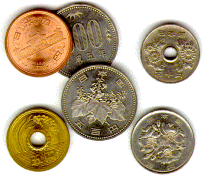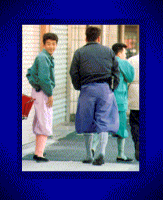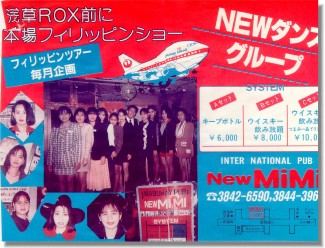
 [March, 1995] We had been warned about the high prices in Tokyo, but were not quite prepared even if we had been to Manhattan before. While at the airport, I decided to buy a stick of lip balm for my chapped lips. It cost ¥400 ($4.00). Then he purchased a paperback, bilingual atlas of Tokyo and a pocket English-Japanese dictionary for the combined price of ¥4,000 ($40). We learned that the prices of items at the airport were higher than those found on the streets of Tokyo. For example: a 12 ounce Coke cost ¥200 ($2.00) at the airport and ¥110 ($1.10) at a vending machine on the streets in Tokyo. On average, the prices seemed to be about 100%-400% higher than similar goods and services in San Francisco at the same time.
[March, 1995] We had been warned about the high prices in Tokyo, but were not quite prepared even if we had been to Manhattan before. While at the airport, I decided to buy a stick of lip balm for my chapped lips. It cost ¥400 ($4.00). Then he purchased a paperback, bilingual atlas of Tokyo and a pocket English-Japanese dictionary for the combined price of ¥4,000 ($40). We learned that the prices of items at the airport were higher than those found on the streets of Tokyo. For example: a 12 ounce Coke cost ¥200 ($2.00) at the airport and ¥110 ($1.10) at a vending machine on the streets in Tokyo. On average, the prices seemed to be about 100%-400% higher than similar goods and services in San Francisco at the same time.


We had a little difficulty finding the place we had made reservations to stay. We were looking for a ryokan and we weren't quite sure what to expect. We stopped by a police box and asked them for help but they only pointed us in the general direction. A stranger came up to help us and explained a little about finding an address in Japan. He started by showing us that we were in the right general area by pointing to Nishi Asakusa on an address sign. Then he explained that of the address 2-18-9, the 2 stood for a section of Asakusa, 18 represented a block of buildings (sometimes it could merely represent one large building), and the 9 represented the location of one residence.
The ryokan looked exactly like a Western building on the outside, as most of the architecture in Tokyo does, but the room was divided into an entry way, a bathroom and a bedroom. The entry had a raised step, before which you take off your shoes. The bathroom had a linoleum floor and a high, square bathtub. The bedroom was about six tatemae mats large and had two futons laid out; a small table with a hot water thermos and a tray with two tea cups on it, and two pillows beside it for sitting on; a remote controlled room heater mounted high on the wall; ample closet space for travelers; and a television set. The proprietor of the ryokan seemed a little too easily amused at our foreignness, but was always exceedingly polite telling us "ohayo gozaimasu," "konnichi wa," "komban wa," and "doomo arigato," when appropriate. The only time he seemed to get angry was when he first showed us the room and I began to walk up onto the step which was right outside the room without taking my shoes off.



We were struck by the newness of the cars in Tokyo. All the cars we saw seemed to be no older than five years old and I can't recall ever seeing cars being driven in public with dents. (I later learned about Japan's shaken system which is a mandatory, automatic inspection of brakes, lights and some car parts that costs about ¥1400, and is preceded by a more thorough manual check of 102 different car parts). Another impression we acquired of Tokyo was that it was a very clean city and that the people as individuals were clean. Everywhere you looked the Japanese concern for cleanliness both in their surrounding and in their persons was in evidence: in dirtiness of shoes, in the detail with which our room was cleaned everyday, the lack of graffiti, the lack of trash on the streets, and the dress of the people (the one exception to the dress of the people was a salary-man who appeared to be in his forties-he had lipstick marks in the impression of a woman's lips on his back left shoulder). As in Korea, we also saw a few people wearing cotton masks tied over their mouth and nose.

Seemingly contradictory to this pattern we had noticed was an individual subway passenger who was picking his nose and brushing his rewards on the floor for several minutes without any remark or sign that any of the other passengers were in the slightest bit affected. A common sight though was to see older men and women spitting on the street.

I asked a man at a woodblock print shop if he had any more prints than a couple of sexually suggestive, though not explicit, prints with "more detail." He told me that he did not, that it was illegal to sell such prints. Later I found a shop where both censored and uncensored books cataloguing shunga prints were sold (shunga is a certain variety of woodblock print defined by its subject matter: erotic couplings). The proprietor explained that even books with shunga prints had previously been censored, but was no longer the case. By the way, he also told me that the lowest price for an original shunga print was ¥100,000.
It was difficult to find pornographic magazines and videos in Tokyo where the pubic and genital region of those pictured is not censored in some way. It was possible to see the pubic region of women in poses that were not innately sexual in nature and there were even magazines with prepubescent girls on the cover with no apparent censorship. Japanese pubic region-censorship seemed quite unusual in such an otherwise sexually open Japan where it is common to see sexually explicit in areas where kids could be seen walking by ads (not being able to read Japanese at the time it might be more appropriate to say "sexually suggestive" because some ads had sexually suggestive photos, one of which had the word "menu" above the photo of a girl's head in front of a man's crouch apparently performing fellatio); and manga magazines (in particular), which have naked cartoons as well as nude photos of women, being sold at subway newstands or as casual reading material aside chairs where bank customers await their turn.
Books have been written on the subject of sexism in Japan, but we noticed two clubs that were for women exclusively in the redlight district of Ikebukuro. Though these two clubs were outnumbered by the rest of the district which appeared to cater exclusively to men they were proverbial trees in the desert.

I approached the two women who stood beside the advertisement for a mabuhay club (Filipina hostess club) at Kokusai Dori. Kathy, who we had seen the previous night, and another lady, Maria, were there. I told them I wanted to know what the different sets: "A", "B", and "C" entailed. They wouldn't tell me directly, but ushered me to the front door. When I got inside the Filipino man, Lito (but referred to by the ladies as kuya, a Filipino term meaning "older brother" but meaning a man who looks after them in this case), I had also met the previous night greeted me. When I persisted in asking them what the sets were, he told me: "A" for ¥6,000 (about $60.00) paid for a seat for two hours, but you had to purchase your own bottle of Henessy and food as well as your hostess's drinks; "B" for ¥8,000 paid for a seat and drinks, but you had to purchase your own food and the hostess's drinks; "C" for ¥10,000 paid for a seat, drinks for you and the hostess, and food. After I ordered "C", thinking it was the best deal since there were no hidden costs, I found out that I was not to be served the Henessy, but a bottle of watered down alcohol that surely lacked more than an ounce of whisky in it. After a short time I decided I would request a drink that, even if it was mostly water, was blended a little better and ordered a large bottle of Sapporo beer. It cost ¥2,000. The initial set was to last two hours and, knowing that I could not read Japanese, they told me after less than that had elapsed that I could purchase an extension of one hour for ¥5,000 (though the sign outside appeared to say ¥3,000).

I asked Lito if Mimi was a Filipino run club to which he responded "yes." Then I asked if it was difficult for Filipinos to run a club in Japan and again he responded "yes." Later I asked my hostess if they had to make payments to the yakuza she also responded "yes."
The club is open daily from 7p.m. until 4a.m. Kathy wanted me to enter the club at first, but seemed concerned when I began to enter it. Then I noticed that she was telling all the other women that I had a Filipina wife. The news spread quickly and I was left with the oldest of the four ladies until I requested the one who had accompanied me with Kathy into the club. There was a small stage so I asked my hostess, Maria, if there was entertainment. She got a little upset and turned to ask Lito, "Kuya, he wants to know if there is entertainment!" Lito came over and explained that the visas for several Filipinas had just expired, but in a couple of weeks a new group of Filipinas and a group of topless women entertainers from Romania would be coming. Then Maria and another woman encouraged me to sing with the karaoke machine, this I found out was the entertainment that was offered.
Maria told me she arrived in October or November, 1994. Showing me her Japanese work visa, she said she would return to the Philippines the following May after her six-month visa expired. I asked what the hostesses did suggesting that I thought they had some degree of sex with the patrons, to which she responded that she was a virgin and had never had sex with a Japanese man or otherwise. She added that "my mother trusts me." While I was talking with her I repeatedly touched my index finger of one hand to the palm of the other as a way of gesticulating the importance of a point I was trying to make. Maria finally stopped me and asked why I was doing that motion. I explained to her and she said that in Japan (and in the Philippines) it means to have sex. I asked her if Japanese patrons made that motion often. She said "Yes, Japanese men always want sex."
When I told her that I didn't want to have sex with her she changed her story. Maria began to tell me a completely different story. She explain that she had two children, a young boy and girl, and that she had separated from her husband two years previously. She said her father was caring for the children in the Philippines and she called them daily. (One of her co-workers confirmed that she had two children and was separated from her husband who was a few years younger than her twenty-five years; this lady said she knew this because she was from the same subdivision as Maria). I continued to press her on the issue of whether she had sex with clients. Still not completely convinced that I did not want to have sex with her, she added this time that "my children trust me." She said she had one older sister, who had also worked as an entertainer in Japan, and three younger brothers. When asked if she was saving any money, she said she was helping her brothers and sending money to her children, and that it was very expensive to live in Japan. At one point she said the others did have some degree of sexual relations with the patrons then later contradicted the statement. She added that it was against the rules to have sex on the premises. Apparently there were lots of rules and penalties (perhaps it was a means to restrain a patron's requests too). There were rules against hostesses drinking and smoking cigarettes in the club, both of which Maria did, and leaving the premises unless attracting business. When asked where they had sex she wouldn't say, but fended off the question with an explanation of where Filipinos in the Philippines have sex "somewhere dark and quiet with music playing in the background."
Maria showed me a book with Japanese and English songs written in it. They were songs for her to practice so she could sing with the karaoke machine as part of her entertaining. The companionship of the hostesses and the music of the karaoke machine was an important part of the entertainment at this club. Later in the evening I noticed the Japanese men receiving back massages from the hostesses and dancing with them with their hands on the hostess' asses but this was the extent of sexual contact I viewed.
Maria had also let me see her address book which contained names of several Japanese men. Several nights later, I think it was a Monday, when I saw a Filipina outside the club near the advertisement I noticed that a couple of the women were using the phone. It was only at that moment that it occurred to me that they have to call men to come to the club on slow nights. When I asked them if this was true they acknowledged that it was.
Knowing of a couple of Filipinas who had worked in Japan as entertainers and subsequently married Japanese men, I asked a couple of the mabuhay club women if they believed they would ever marry a Japanese man. They both replied emphatically "no!" I was somewhat surprised and asked them why, to which one of the women replied, "Because they're freaks!" I suspected that they were referring to the sexual aspect of the Japanese male personality - as Maria intimated earlier-that they had encountered so I asked, "Why, aren't Filipino men babaeros?" (a babaero can be loosely translated as a man who plays around with several women, whether he is married or not). The same woman responded, "Yes, but Japanese men are mas babaeros" (mas means "more").

